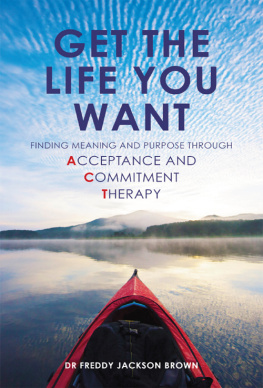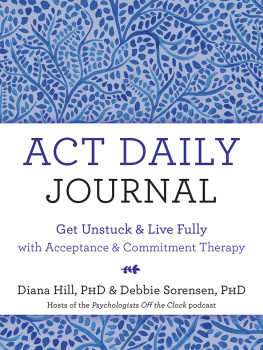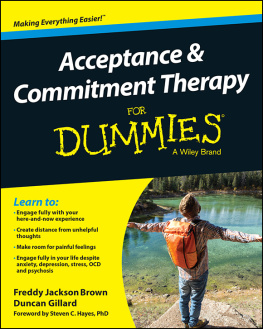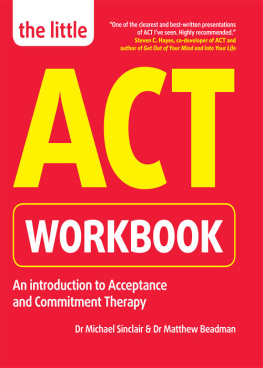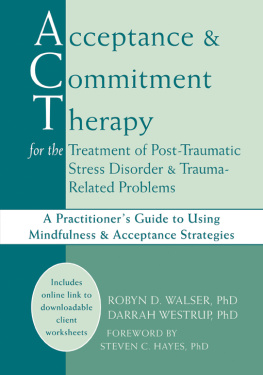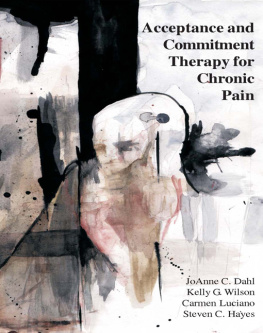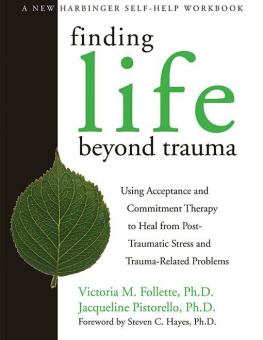GET THE
LIFE YOU
WANT
FINDING MEANING AND PURPOSE THROUGH
ACCEPTANCE AND
COMMITMENT
THERAPY
DR FREDDY JACKSON BROWN

For my parents, Monika and John. Inspiration & Love.
Dr Freddy Jackson Brown is a husband, father, behaviour analyst, cyclist, dog walker and smallholder. He is an ACT practitioner and works as a clinical psychologist with disabled children and their families. Freddy has published over 20 research and professional articles in peer reviewed journals and books. He provides teaching for postgraduate University training courses on child development, disability and communication.
Acknowledgements
Writing this book would not have been possible without the support and encouragement of my family and friends, teachers and colleagues. A special thank you to my wife, Helen, without you I simply couldnt have done it. And thanks also to Helen Bolderston and Duncan Gillard for your feedback and conceptual rigor on the earlier drafts.
Introduction
A STUBBORN TRUTH ABOUT life is that its hard to be happy. Everyday people all around the world wake up feeling stressed, disconnected, lost, anxious, confused and depressed about their lives. We long to be happy and free from the difficulties we face. We long for life to change so that we might be happier. The question is how? A common assumption, fed by our mainstream culture, is that to be happy, we have to be free from any unhappiness. Happiness equates to not being sad. We conclude that the path to happiness is paved by the absence of unhappiness. We just need to get rid of our depression, stress or pain and all will be well (or at least better). As a consequence, a lot of effort goes into trying to reduce, avoid or free ourselves from any negative experiences we have in life, irrespective of their meaning.
When we look at our experience, we see that a lot of our difficulties are related to how we are feeling (anxious, stressed, depressed) and what we are thinking (Im stupid/useless/ugly). Its quite natural to conclude that if we didnt have these bad thoughts and feelings, our lives would be much better. This sets us on a course of trying to purge ourselves of particular unwanted beliefs, ideas, feelings and memories. Indeed, a lot of traditional therapies are based on this idea change or correct your negative or inaccurate thoughts or take drugs like antidepressants to get rid of the bad feelings.
The strategy of trying to get rid of bad stuff in order to feel better makes a kind of logical sense, and it works in the everyday, external world. If you have a stone in your shoe, you remove it and you feel better. If someone is causing you stress, keep away from them. Or if your job is getting you down, look for another one. Getting rid of, changing or avoiding negative things clearly works in some cases. The problem is that this approach doesnt work very well in the psychological world with our thoughts and feelings. What we find is that we cant get rid of a thought or change an emotion in the same way we can get rid of and change things in the external world. And if it was that straightforward to change our thoughts to stop having bad ones and only have good ones, we would all do it and that would be the end of it. Personally, I cant do it. Whats more, the research shows this strategy doesnt really work either.
Levels of unhappiness in western societies have increased in the last 40 years in spite of a range of therapeutic techniques. Maybe society is harder to live in today and it is simply harder to be happy. Maybe. But it might also be that our ideas about happiness arent quite right. Maybe weve fallen into what psychotherapist Russ Harris called the happiness trap. The trap is the idea that we just need to remove our negative thoughts and feelings and then we can be happy once more. Its a nice idea, but its missing something important.
Today there is also a common presumption that happiness is normal, and if you arent happy, then something is wrong with you. This puts a heavy expectation on us to be happy, and it means being unhappy is itself something to be unhappy about. If left unchecked, this idea can set off a vicious cycle of ever-increasing unhappiness.
This book presents an alternative way to understand and approach happiness. It is based on the new therapeutic model of Acceptance and Commitment Therapy (ACT, said as a single word). The message at its heart is simple rather than pursuing happiness as a goal in its own right, instead we should aim to live a full and meaningful life and let happiness look after itself.
Happiness is clearly important. It matters to us all. The American Constitution even sets out the pursuit of happiness as a fundamental right. That is fine as long as we dont see happiness as an end in itself. That is putting the cart before the horse. Happiness comes from living a life of purpose and meaning; it is a consequence, not the cause. Happiness shouldnt be our goal; its what we feel when we achieve our goals.
When a question goes unanswered for a long time, perhaps its time for a new question. Maybe we should be asking new questions about happiness. Rather than asking How can I be happier? or How can I not feel depressed/anxious/bad?, maybe we should be asking How can I live a life with meaning?
How to use this book
Many books based on the ACT model open with how to overcome the barriers we face when trying to live a more meaningful life. The advantage of this approach is that you can be prepared for the obstacles you are likely to face before you start on your journey of change. The downside is that you might not be sure why you are bothering.
This book takes a different approach. It starts with your motivation and the reasons for making changes. In ACT, we call these your values. You might think that you already know exactly why you want to change your life, but that is not always the case. Many people are inclined to focus on what is wrong with life, rather than what might bring more meaning and vitality.
All the chapters in this book work together to create a programme for making a real and lasting change. This means that information presented in one chapter is relevant to (and may sometimes be repeated in) other chapters. As you move through each chapter of this book, the aim is they each present different aspects of the ACT model. The exception to this is the last chapter, which looks more broadly as what it means to be happy in modern society.
Chapter 1: A Life Worth Living: The ACT agenda looks at how hard it is to be happy and how our difficulties really start when we begin to struggle with unhappiness. I introduce the ACT model and explain why the mind can find it counterintuitive. I also look at two of the core features of ACT self-compassion and mindfulness.
Chapter 2: Digging in a Hole looks at how to give up on our self-defeating thoughts, feelings and behaviour. A major challenge we can face is how to give up the futile task of trying to control our thoughts and feelings in order to feel happier. This chapter will help you work out when your efforts to make life better are in fact self-defeating and how to stop and do something else.
Chapter 3: The Why of Life looks at what you want your life to be about. In ACT, this is referred to as our values. Values are the things that matter to you, the things you want to define your life. The chapter sets out a number of exercises that you can use to begin to think about your values. Once you know your values, what you want your life to stand for, you can start the process of making them come alive.

